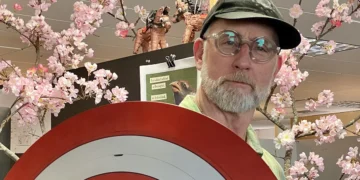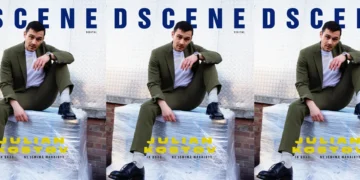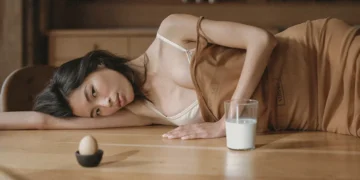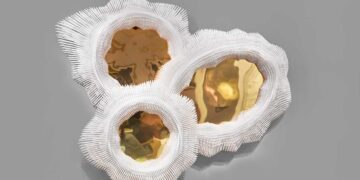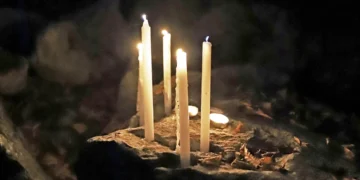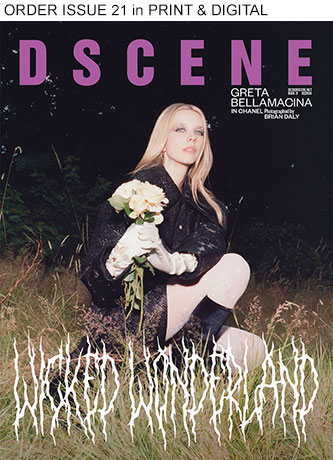
Marvel’s Captain America: Brave New World introduces a high-stakes political landscape, with Sam Wilson caught in the aftermath of an international crisis involving President Thaddeus Ross. Production designer Ramsey Avery played a key role in shaping the film’s environments, ensuring every space reflected the story’s depth and complexity. One of his biggest challenges was reimagining the White House, a setting that symbolizes power and leadership. Taking cues from Jackie Kennedy’s forward-thinking renovations in the 1960s, Avery crafted interiors that align with Ross’s vision for the future while maintaining a sense of historical continuity. His approach involved extensive research, custom furniture sourcing, and even hidden details like printed carpet patterns and subtle easter eggs in wallpaper designs.
INTERVIEWS
Beyond architecture, Avery brought a cinematic language to the film through color. Inspired by 1970s political thrillers, he designed a unique system where colors represent emotions rather than characters: blue for control, red for chaos, green for internal conflict, guiding the audience’s subconscious experience throughout the film. To further ground the story, he prioritized shooting on location, transforming real spaces in Washington D.C. and Atlanta to reflect the film’s tense political atmosphere.

In this exclusive DSCENE Magazine interview, editor Jana Kostic speaks with Ramsey Avery about bringing Captain America: Brave New World to life through production design. From reshaping the White House to match President Thaddeus Ross’s vision to crafting a color script driven by emotion, Avery shares how he balanced historical authenticity with Marvel’s cinematic world.

What first sparked your passion for production design, and was there a moment where you knew it was the right path for you?
In reality, my first love was theater design. I started college at the University of Wyoming studying physics – I wanted to help learn how the universe began. I had, however, always enjoyed working in all kinds of theater positions, from acting to directing to writing to designing. After finally getting cast in – and truly enjoying – a college production, I had an existential crisis – I loved theater, but I also loved studying the stars. I had an uncle who was a well-known astronomer and who also loved the arts and preferred this advice: “There is no money to be made in astronomy, and no money to be made in theater. Where do you want to spend the rest of your life not making money?” My heart was pretty clear.
That led to the opportunity to be the first student at UW allowed to design a main-stage production. It was a wonderful experience. The director wanted to have the set design emphasize the trials and fears of the main character, making the space support moods that could be light or terrifying. That really illuminated how crafting the space, the colors, and the atmosphere of a production gathered the audience into the story we were all trying to tell. The sets affected the story, which affected the audience. That was exhilarating.
It wasn’t until I graduated from grad school in set design and landed a job the very next day on a major sitcom that I realized how theater design informed media production design – it was the same skill as sculpting the environments to tell a story. The designers I worked with were skilled theatrical designers but also great production designers. They continued to teach me how selecting colors, textures, styles, cultural references, and lighting affected the way an audience perceived a story. In some ways, sitcoms took that to the extreme – I once had a director on a pilot I was designing tell me how to design a “funny staircase,” not one that looked funny, but one that physically facilitated the actor telling a joke.

You’ve designed for massive projects, from Marvel to other big productions. What’s one thing you always bring to every set?
“A passion for story.”
No matter if the project is tiny like The Waitress or massive like Captain America: Brave New World, design is always about the story: what is that specific tale we are trying to tell? More importantly, do we want the audience to feel through that story? How do we create a visual world, one that supports the actors playing their roles to create that feeling? What are the visual clues that support the themes and intent of the story the directors or showrunners want to convey? It is my job to craft that visual narrative, and I care passionately about working with the rest of the creatives to find it.
On a big project like this, it can be easy to get lost in the bells and whistles, in a desire to make it “cool” or “epic.” But that doesn’t tell the story. What I do is always dig deep with the director to find the key elements that they want the audience to learn and feel, and then use research, art, and the elements of design to sculpt the world that lets the actors play their characters truthfully. Then, the rest of the team, from costumers to composers, add their layers to guide the audience on the director’s path.

How did working within the Marvel universe influence your approach to production design compared to your past projects?
I have had many opportunities to work with Marvel in many ways. Beyond the film work as a production designer or supervising art director, I also designed the recent Avenger’s Campus and Webslingers ride at the Disneyland resort.
In all cases, it is great to go back to the source – the comics – to look at how those artists use design to tell the story: colors and composition, “camera” angles and points of view, the way a panel or a page can be very simply designed but complexly evocative. How does the character’s action play across a background to convey a feeling or compel the narrative?
When you look at comics as a production designer, you are instantly humbled that the backgrounds are relatively unimportant. Because the frame often must be very simple to emphasize the character, the “production design” is often just a series of simple lines and block colors.
In the case of Captain America: Brave New World that nature dovetailed completely with how the director, Julius Onah, wanted to tell the story. He wanted to emphasize the political thriller sense of this movie, not as a filmmaking gimmick, but as a method to illuminate how Sam Wilson finds his way to confidently take over from Steve Rogers as Captain America. He wanted the political machinations and the sense of who is controlling what to provide the framework and challenges Sam negotiated to learn to control his place as Cap.
Toward that end, Julius referenced a lot of period thrillers, from Le Samourai to Point Blank to The Parallax View and many others, plus other movies with interesting qualities of control, like Trance or The Killing of the Sacred Deer. In all those movies, even though they had different design styles, there was a common thread of what he called “meticulous design.” By that, he meant controlling the frame – the colors, the lighting, the composition – in such a way as to focus on where the characters were in their story arcs. Which is exactly the same way comic book frames and pages work. So, we worked to craft designs, whether in designing a set or finding a location, that allowed the DP, Kramer Morgenthau, ways to simplify the frame in that way.
The other thing we did based on the comics was take a very serious look at color. Rather than color coding to the characters or to locations, we created a color bible that tracked the emotions we wanted the audience to feel as part of Sam’s journey, from the blues representing control to an increasing sense of agitation through greens and yellows (pulling from the production design philosophy of the Ed Norton/Louis Leterrier Hulk movie), to the ambivalence of purple and the loss of control exemplified by stronger and stronger shifts from orange to red. That red, of course, plays exactly to the themes and chaotic nature of the Red Hulk.

What was the collaboration process like with the film’s director and other departments to make sure the visuals matched the film’s tone?
The biggest part of that is just keeping communication open. I share research, as it develops and is finalized, with not just the director and producers but also with the DP, the costume designer, VFX, and the full art department. As we develop concept art and concept models, we discuss them with the other crafts to make sure we are blending with the conversations they are having separately with the director – and to make sure we can build our work in time and on budget.
In a tentpole movie, like one at Marvel, it is especially critical to share concept design with VFX. We want a smooth handoff between the practical and the digital, one that carries fully through post-production when the Production Designer is often on to other projects – also the financial model of studios won’t fund their involvement any longer. That handoff starts with collaborating from the first concept designs, often before I even show a design to the director.
In particular, for this movie, we adapted a process from animated films where we did a color script for the entire movie. We took that color pallet we had developed and applied it to a key frame from every scene, clarifying the color, composition, and mood we were looking for in each one. That way, we could help all of the department heads go in the same direction. This guided things as varying as the lighting in a prison fight sequence to the stripes on Ross’s tie when the movie opens to the panel behind a character’s head in a hospital setting.
This also allowed us to explore one of the key design themes of Sam’s journey – how his worries about being Cap have him boxed in at the start of the film. By the end of the film, we wanted those boxy spaces we started the film with, compressed by volume or by light, to open out into wider spaces where Sam can take control of his destiny and prove to himself that he doesn’t have to be a super soldier to be Captain America.

What was the process like for you in balancing historical authenticity while ensuring you reflected a unique version of Ross’s presidency?
Ross appears in this movie in almost entirely historically accurate environments, from the White House to battleships to various government functions in other countries. Julius wanted those to be as realistic – and as honest – as possible.
This fit a huge directive from Marvel for this movie – that this project be “grounded.” That is, they wanted to move away from the more fantastical elements of recent movies to things that felt more visceral and recognizable in our world.
A simple example of that was the desire to move away from holograms. This created complexity in how to stage the East Room conference. We needed a way to show expository visuals that still allowed the audience (and the camera) to see the President and all the attendees, plus also created a compelling space for action. To achieve that, I looked at current OLED tech and then projected currently available transparent screens into something a little more advanced. That gave us an interesting, clear screen – hologram free! – with the added dramatic action when Isaiah takes a shot at the President, shattering that glass.
“That is an example of how production design can make choices that guide the story, the emotions, and even the specific action. But more importantly, it is an example of how “grounded” can still be very cinematic.”
The White House, as a whole, was tricky – there are so many different versions of those spaces through history in the real world, and also so many versions shown on screen. We needed to tell Ross’s story through this design. He is a man who has been angry and violent, often to good effect for his career and for his service to the country, but with serious personal consequences. Now, he wants to lead the country in a time of healing from all the recent events in the Marvel multiverse. He wants to look forward and inspire optimism. We looked back to other presidents with the same goal: Reagan and, especially, Kennedy. A lot of the design details are inspired by Jackie Kennedy’s version of the White House – drapes, wallpapers, compositions, and even the Rose Garden layout. All to evoke Ross’s underlying desire to evoke optimism and move away from his violent past.

What details in the White House interiors best reflect President Ross’s character?
A lot of artwork in the White House harkens back to America’s founding battles. To support Ross’s desire to change how people perceive him, we limited that and instead went with aspirational leaders and calming landscapes.
We didn’t shy away from his masculine energy, though. Like Reagan, we let him have an appreciation for the Wild West, a time when, for all its clear faults and complications, people were remaking themselves and at the same time, shaping an optimistic sense of America. In the Oval Office, we used Remington sculptures and Hudson School-style landscapes.
There was a scripted bit where Ross was giving up smoking, so we originally gave him a bowl of lollypops on the Resolute Desk to chomp on instead of cigars, echoing Reagan’s jellybeans. Mr Ford also wanted a bit where Ross learned the art of ikebana as a meditation to control his anger. So, we gave him a featured flower arrangement. Of special note, we know he has a very fraught relationship with his family, and he wants to clean that up, so we wanted to make sure they were very present in the Oval Office. We placed their photos right behind his desk.
As we looked at the scene on the shoot day, though, we realized that it needed to be much more spare. The main scene in this set was about loss and coming to terms with his history – all the dressing on the desk and the flowers on the coffee table were too fussy to convey the mood of the scene. So we stripped it all away and left only the essentials – a few practical items on the desk and the photos of his family.
We also wanted to emphasize our themes of control and safety vs anger and chaos in the White House sets, using our colors of blue versus red. So, we first see Ross in the Blue Room, where he meets Sam and expresses his desire to control a new version of the Avengers. But we contrast that with the next scene, where we see him stride out onto a brilliant red carpet and into a room of amber, the East Room. Amber is our color where control starts to slip away.
We brought that blue into the Oval Office in the carpet, drapes, and upholstery (much like Kennedy’s Oval Office). At this point in the movie, Ross thinks he has regained control, so we wanted to emphasize that with our colors.
And, as much as we could in a building that celebrates red, white, and blue, we minimized the red. Our catchphrase was “Deny Red.” All this color work was to convey Ross’s desire for stability, safety, and control.

Instead of assigning colors to characters, you linked them to emotions. How did this concept shape the overall visual language of the film?
I included some in the examples above, but there are definitely a couple that come to mind. Where Isaiah is held in prison, instead of using the blue of control and safety, we used yellows and oranges, representing tension and losing control. Police lights play in red and blue on Isaiah’s face as he comes out of mind control and has to decide how to proceed. The telescopes hiding Camp Echo One are lit with red as a foreshadowing of the chaos that will be unleashed within. There are green and yellow lights in the White House Bunker set to offset the blues – things are not in as control as they think they are. I could go on and on.
Are there any hidden details or Easter eggs in the set design that fans should look out for?
Have to let the Marvel Easter Eggs be left to be found by the fans!!
Some subtle details were worked into various designs. One of our other main themes in the design, beyond color, and the travel from boxed in to open, was reflection. Both Sam and Ross are on a journey of self-reflection, figuring out who they are and want to be. We worked a lot of that into the movie. Some examples are: the broken planes of reflection in the opening sequence of Ross’s acceptance speech, the distorted reflections of Sam and Sterns in Camp Echo One, and the reflections of Sam in the operating room window after the fight at Celestial Island.
There are also some symbolic patterns in the graphics of the design. For example, the wallpaper in the White House Blue Room has lines linked to the web, suggesting that at the start of the movie, Ross and Sam are already trapped in the web. Similarly, we had vertical bars in the wallpaper of the Oval Office to show that Ross didn’t know it, but he was still trapped.
There are places where a deep back story has been developed for the environments and actions that are revealed through design. In Camp Echo One, for example, we looked at research on how prisons tried to control prisoners in the mid-last century. We discovered an experiment where clinicians tried to use colored light to control prisoners’ moods. This led to working out a way for Sterns to use light for mind control. You see the original light fixture, large and chunky, in the first prison cell. Then, in the lab set, Joaquin discovers a series of devices where the lighting is more and more miniaturized.

Looking back at your work on Captain America: Brave New World, is there a particular design element or detail that you’re especially proud of?
There is a straightforward answer to that – the cherry trees of the Hains Point were very tricky to figure out how to make and prepare for a filmable set, and I’m really proud of how that large set turned out. Plus, the idea of the busted concrete for that set came very late in the process and we had a very short time to work it out. All of that was tricky, in fact, we actually had to build the undestroyed set first, then build the destroyed set on top of that! This allowed us to shoot out the aftermath, which was longer and more complicated to build, and then quickly remove it to shoot the actual fight sequence.
That answer, though, infers a deeper answer that I am more proud of: the whole process of how production design guides the development of the story. Those cherry trees were not the initial idea for how to end our story. We started off with a very different journey through the Naval Research Laboratory. That was a sequence that was all about tech and adamantium and teamwork. We did a series of designs around it, working out various sets we could build or, based on our budgetary and schedule needs (always a key, but often unacknowledged, part of the design process!), various locations we could adapt. There were some exciting and visually grand ideas in there, with all our characters – Sam, Joaquin, Carl, and Ruth working together to defeat the Red Hulk.
But as we worked through all those options, they just didn’t feel right to any of us – they weren’t truly serving the story, serving how we could complete Sam’s and Ross’s character arcs. Julius, the director, hit upon the idea of the cherry trees as something that felt true to the history of Ross and his family and then showed how Sam could prove his strength to himself. It completed our arc from boxed-in spaces to open expressions and played the blue of Cap’s costume against the red of the Hulk. It would take place in an environment that had a modification of our chaos red and kept to our need for simple backgrounds of “meticulous design.”
We would not have gotten there without the heroic efforts of the whole Art Dept, who deeply explored the other story options with commitment and talent. This link of design to discover and guide the story happened in many instances. The first battle where Sam and Joaquin procured the adamantium started first in the slums of Manilla, went to the markets of Istanbul, then on to a private airport hangar in Cancun, and then to the runways of that airport. It finally landed in the Oaxacan monastery. The Camp Echo One set went through a similar evolution from a large, more sci-fi and “Marvel” prison to a creepy, concise and controlled military lab.
Each of those environments had the same commitment to character, story arc, and “meticulous design,” applying our rules of color, shape, and composition. I was deeply proud of that work, especially figuring out what multiple countries mining and refining adamantium might look like.
“But I am prouder yet of how our design work helped guide the director and the producers to really hone the story and the characters. In each design, we learned something more about how we wanted to shape and clarify the audience’s experience.”
We brought each sequence more and more to a grounded simplicity, one that told a more specific and deliberately emotional story of Sam’s journey.
Through all of that, we were able to take a design that, on its surface, looks very simple and still gives it deep underpinnings in thought and emotion. This development process isn’t a bug in the system or a waste. It is part and parcel of how we discover to tell these complex visual narratives. I am very, very proud of how our Art Dept team, and the whole production, was able to keep to it with passion and skill to come out with a story that rejoiced in Sam as the new Captain America.

